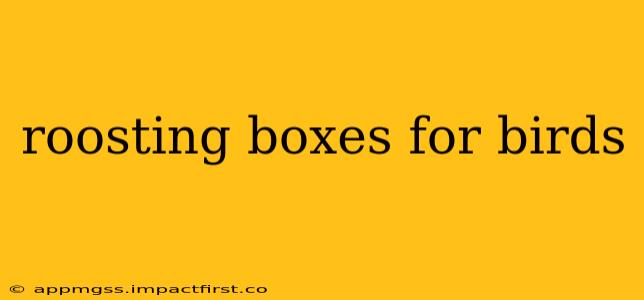Attracting birds to your garden is a rewarding experience, offering a symphony of chirps and a vibrant splash of color. Providing suitable roosting boxes can significantly enhance your chances of attracting a diverse range of feathered friends. This comprehensive guide explores everything you need to know about roosting boxes for birds, from choosing the right design to successful placement and maintenance.
What are Roosting Boxes?
Roosting boxes, sometimes called bird roosts or bird shelters, are artificial structures designed to provide birds with a safe and protected place to rest, particularly during harsh weather conditions or at night. Unlike nesting boxes, which are specifically designed for breeding and raising young, roosting boxes simply offer a secure haven for birds to shelter. They are crucial, especially during colder months when finding natural shelter can be challenging.
What Types of Birds Use Roosting Boxes?
Many bird species benefit from roosting boxes, including:
- Smaller songbirds: These birds often appreciate the protection offered, particularly during storms or cold snaps.
- Woodpeckers: While they may excavate their own cavities, a pre-built roost offers a ready-made shelter.
- Sparrows: These common birds readily utilize roosting boxes, especially in urban areas with limited natural shelter.
- Nuthatches: These acrobatic birds often roost in crevices, making a sheltered box an attractive option.
How to Choose the Right Roosting Box: Size and Design
The size and design of your roosting box should consider the species you want to attract. Generally:
- Size: A larger box accommodates more birds, but smaller boxes provide a more secure feeling for smaller species.
- Entrance: The size of the entrance hole should be appropriate for the target species. A smaller opening discourages larger birds and predators.
- Materials: Durable, weather-resistant materials like untreated wood are ideal. Avoid treated lumber as the chemicals can be harmful to birds.
- Ventilation: Ensure adequate ventilation to prevent moisture build-up.
- Drainage: Add drainage holes in the bottom to prevent water accumulation.
Where to Place a Roosting Box?
Placement is crucial for the success of your roosting box:
- Height: Mount the box at a height suitable for your target bird species, typically between 6 and 15 feet above the ground.
- Location: Position the box near a source of food and water, such as a bird feeder or birdbath. Consider placing it in a sheltered area, away from direct wind and rain.
- Facing: Orient the entrance away from prevailing winds and direct sunlight.
- Security: Ensure the box is securely fastened to prevent it from falling or being easily accessed by predators.
How to Maintain a Roosting Box?
Regular maintenance is essential to keep your roosting box clean and inviting:
- Cleaning: Clean the box annually, preferably during late winter or early spring, when birds aren't using it. Remove old nesting material and debris.
- Inspection: Regularly inspect the box for damage or signs of infestation.
- Repair: Repair or replace the box as needed to ensure its longevity and effectiveness.
What Materials are Best for Building a Roosting Box?
Untreated wood is the preferred material for its durability and safety for birds. Cedar is a popular choice due to its natural resistance to rot and insects. Avoid pressure-treated lumber as it contains chemicals harmful to birds.
Can I Use a Nesting Box as a Roosting Box?
While a nesting box can be used as a roosting box, it's not ideal. Nesting boxes are designed specifically for breeding and often have features that may not be suitable for general roosting, such as internal dividers or a smaller entrance hole.
Do Roosting Boxes Attract Predators?
There's always a risk that predators could target birds using a roosting box. However, careful placement and design, including a secure mount and appropriately sized entrance hole, can minimize this risk.
How Many Roosting Boxes Should I Put Up?
The number of roosting boxes you need depends on the size of your yard and the number of birds you hope to attract. Starting with one or two is a good way to begin and see how they're utilized before adding more.
By carefully considering the factors outlined above, you can successfully attract birds to your garden and provide them with the safe and secure roosting boxes they need to thrive. Remember, providing a haven for these feathered friends adds beauty and biodiversity to your surroundings.
